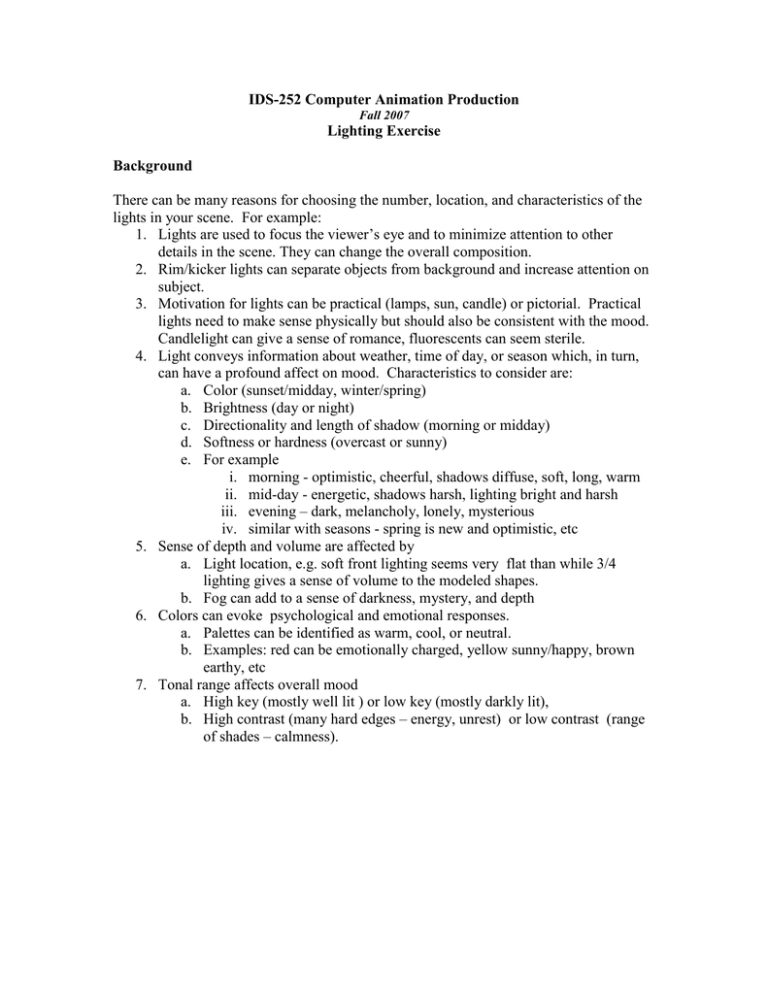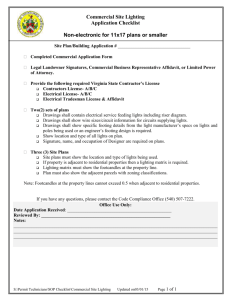lighting exercise
advertisement

IDS-252 Computer Animation Production Fall 2007 Lighting Exercise Background There can be many reasons for choosing the number, location, and characteristics of the lights in your scene. For example: 1. Lights are used to focus the viewer’s eye and to minimize attention to other details in the scene. They can change the overall composition. 2. Rim/kicker lights can separate objects from background and increase attention on subject. 3. Motivation for lights can be practical (lamps, sun, candle) or pictorial. Practical lights need to make sense physically but should also be consistent with the mood. Candlelight can give a sense of romance, fluorescents can seem sterile. 4. Light conveys information about weather, time of day, or season which, in turn, can have a profound affect on mood. Characteristics to consider are: a. Color (sunset/midday, winter/spring) b. Brightness (day or night) c. Directionality and length of shadow (morning or midday) d. Softness or hardness (overcast or sunny) e. For example i. morning - optimistic, cheerful, shadows diffuse, soft, long, warm ii. mid-day - energetic, shadows harsh, lighting bright and harsh iii. evening – dark, melancholy, lonely, mysterious iv. similar with seasons - spring is new and optimistic, etc 5. Sense of depth and volume are affected by a. Light location, e.g. soft front lighting seems very flat than while 3/4 lighting gives a sense of volume to the modeled shapes. b. Fog can add to a sense of darkness, mystery, and depth 6. Colors can evoke psychological and emotional responses. a. Palettes can be identified as warm, cool, or neutral. b. Examples: red can be emotionally charged, yellow sunny/happy, brown earthy, etc 7. Tonal range affects overall mood a. High key (mostly well lit ) or low key (mostly darkly lit), b. High contrast (many hard edges – energy, unrest) or low contrast (range of shades – calmness). Exercise: Form a group of 3-5 people . Pick one scene from each of your animations in which to base your answers to the following questions. 1. Which scene have you chosen? 2. Where do you want to focus the viewer’s attention? Are there details that need to be highlighted or toned down? 3. How would you describe the overall mood of the scene? 4. Whether or not the weather, time of day and season is directly relevant to your story, it is a good idea to specify them as a way of providing background, consistency and motivation for the lighting. a. What is the time of day and season? b. What is the weather? c. How do your lights convey this information? 5. Identify all practical sources of lights in the scene. For example, are there actual lamps in the room? Is there sunlight coming in through a window? 6. Based on your answers above regarding mood and time: a. Identify and explain the color palette you plan on using. b. Identify and explain the tonal range you plan on using (high/low key, high/low contrast) c. Will shadows be long or short, soft or hard? d. What sense of depth do you want to convey and how will use lighting to do this? 7. Based on your answers above, identify the specific practical as well as the pictorial lights you plan on using. Pictorial lights are lights not associated with any apparent source but are used to help tell the story and set the mood. How many lights will there be, what is their color, their quality, etc? Will you use three-point lighting (key, fill, kicker)? Everything you do should be done for a reason and should support the telling of the story. Note, the above discussion is focused on lights but similar questions regarding directing the viewer’s eye and establishing mood can be applied to a discussion of shading and texturing.



